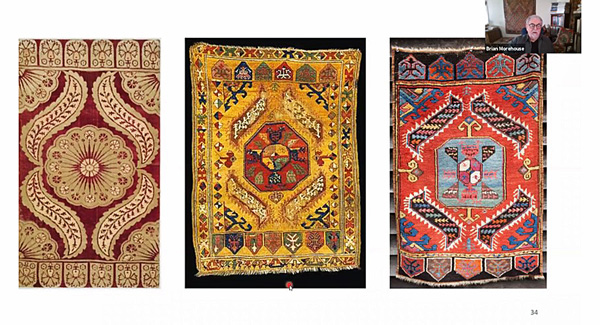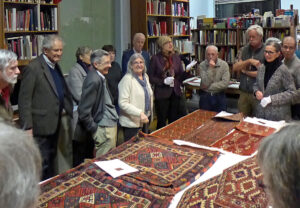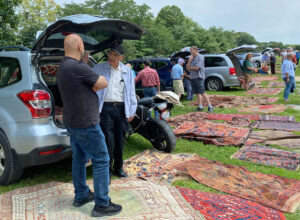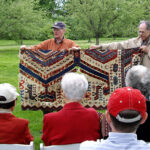Events
NERS now offers two main types of programs
Webinar Series
The webinar series continues, drawing speakers and attendees from all over the world. A typical webinar utilizes Zoom to present a renowned speaker addressing a particular topic, with many stellar weavings as illustrations.
The webinar series has already attracted a group of rug and textile luminaries as speakers, including Jim Burns (Caucasian and Kurdish rug collector and author), rug scholar Walter Denny, and many more.



In-Person Meetings
Those within or near the New England area can take advantage of NERS’ other main type of program — in-person events. Most are speaker presentations; other in-person events include a traditional annual picnic with show-and-tell, and museum and gallery visits to exhibitions of oriental rugs.
Among the speakers featured at past in-person events have been such internationally respected rug experts as noted author Jon Thompson of Cambridge, England, rug scholar Elena Tsareva, (former curator of the Russian Ethnographic Museum, St. Petersburg), Belkis Balpinar, (founding director of Istanbul’s Vakiflar Museum), Parviz Tanavoli, (Iranian tribal rug expert), noted German carpet collector Heinrich Kirchheim, Josephine Powell, (Istanbul-based doyenne of Anatolia’s ethnographic researchers), and HALI co-founder Robert Pinner.
Upcoming Events
Webinars
Ever-popular speaker Walter Denny joins NERS for his third webinar. Expanding on his provocative and engaging keynote address at the recent International Conference on Oriental Carpets, Walter will look at the future of carpet studies, noting that, unlike other areas of art history, our current knowledge of more recent carpets is primarily founded on, and continues to be furthered by, information from the marketplace.
Registration link:
In Anatolia, the 15th century was a turbulent era; after an invasion by Tamerlane’s forces, the Ottomans managed to regain and expand their power, conquering Constantinople and forcing resettlement of Anatolian Turkmen tribes. Deniz’s presentation examines so-called Varsak kilims from southwestern Turkey. He will maintain that these kilims can be associated with the late-15th century relocation of a group of Turkmen tribes.
Registration link:
https://tinyurl.com/DenizFringeplus
A finely woven rug held in the Konya Ethnographic Museum, dated to the 17th century, is actually a uniquely conceived Rum Seljuk-era prayer rug. Hewing closely to the generally accepted notion that epigraphy – the practice of adorning artifacts with text – is a foundation of Islamic art and culture; Hayes will show that the rug’s designer used pseudo-epigraphy to inscribe the divine name. This design evokes the mystical idea of a ‘concurrence of opposites’.
Registration link:
https://tinyurl.com/SeljukNERSfringefb
NERS joins the Textile Museum Associates of Southern California (TMA/SC) to co-sponsor.
Registration link:
The Levant, the culturally diverse territory of the eastern Mediterranean, came under Ottoman rule from the 16th century through the end of World War I. A cluster of silk weaving centers emerged in the Ottoman period encompassing both cottage industries and established workshops. The talk will outline the geopolitical influences on this textile group and present a range of silk garments, accessories and textile panels from the Ottoman era Levant.
Registration:
The Levant, the culturally diverse territory of the eastern Mediterranean, came under Ottoman rule from the 16th century through the end of World War I. A cluster of silk weaving centers emerged in the Ottoman period encompassing both cottage industries and established workshops. The talk will outline the geopolitical influences on this textile group and present a range of silk garments, accessories and textile panels from the Ottoman era Levant.
Registration link:
Registration link:
Joining us from Istanbul, Deniz will trace the history of dyeing in Türkiye and will demonstrate organic and mineral source materials and how they are combined to make a large variety of colors. He will also show historical rugs and textiles where these were used and discuss their local cultural significance.
Registration link:
Christian and Dietlinde Erber share a longtime collecting passion dating back to the 1978 International Conference on Oriental Carpets (ICOC) in Munich. The Erbers will present a personal overview of their collecting life – how it started and developed into a passion and how their collecting focus evolved. Showing pictures of some of their favorites, they will trace the evolution through Anatolian kilims, Turkish towels, Ottoman embroideries, and Central Asian suzanis and ikats.
Registration link:
In-Person Events
Bring your Persian pile weavings—whether they were
made in urban workshops, town or village homes, or
tribal tents—to this friendly show-and-tell meeting! After
food and refreshments (provided, as at the picnic, by NERS),
members of our Steering Committee will start things off
with a few representative rugs and trappings of their own.
Then we’ll turn to whatever you bring—big or small, antique
or more recent—about which we encourage your comments,
not just on where and when your examples were made, but
also about what attracted you to them.
To provide the right amount of food, we need your
response not later than October 5. RSVP—indicating your
name and the names of those coming with you (guests
welcome, and welcome to bring rugs!)—to Jim Sampson:
[email protected].
Please join us at our meeting at the Newton Historical Society’s Durant-Kenrick House.
Bring your non-pile weavings— patterned-on-the-loom textiles known by such terms as kilim, sumak, cicim, jajim, zili, verneh, etc.—to this friendly, in-person show- and-tell meeting!
Sunday, August 10
Noon to Four pm
Gore Place 52 Gore Street
Waltham, MA
RSVP by August 3 to Jim Sampson at [email protected]
Please join us at our meeting at the Newton Historical Society’s Durant-Kenrick House.
Bring your embroideries – textiles patterned by needlework – to this friendly, in-person show-and-tell meeting. They can be big or small, antique or more recent, and from anywhere in the world. We encourage comments, not just on where and when your examples were made, but also about what attracts you to them.
Event Archive
Previous Webinars
2024 Webinars
Piece by Piece It Disappeared: Reconstructing the Chehel Sotun Carpet with Maggie Squires of The Courthauld Institute on February 10, 2024 at 1PM Eastern Time
Maggie Squires’ webinar will focus on a massive carpet woven in the Deccan for the Chehel Sotun palace in Isfahan in the 17th century. The carpet was cut up and sold piece by piece from the palace in the late 19th century, and the fragments are now distributed across at least 11 collections across the world. Maggie’s research traces the history of the carpet and uses digital methods to virtually reconstruct the complete carpet based on archival evidence, historical descriptions, and physical examination of the fragments. The reconstruction has implications for our understanding of Safavid palaces and their furnishings in the 17th century and the artistic exchanges between Iran and the Deccan at that time.
A fascinating tale of Alberto Boralevi’s forty years of hunting in Italy for carpets existing in museum storage or in holdings of ancient aristocratic families.
2023 Webinars
Pull of the Thread: Textile Travels of a Generation with Sheila Fruman on October 21, 2023 at 1PM ET.
On Saturday, October 21, NERS will co-sponsor “Pull of the Thread: Textile Travels of a Generation,” hosted by Textile Museum Associates of Southern California (TMA/SC).
In this webinar, presenter Sheila Fruman will focus on nine intrepid travelers who, in their free-spirited youth, combed the streets and bazaars of Central and South Asia in search of the Kashmir shawls, Uzbek embroidered and ikat textiles, Anatolian kilims, and Turkmen carpets that inspired their subsequent vocations as dealers and scholars.
Sea Change: Ottoman Textiles 1400-1800 with Amanda Phillips on October 7, 2023 at 11AM ET.
In the Ottoman Empire in particular, the sale and exchange of silks, cottons, and woolens generated an immense amount of revenue and touched every level of society.
Trade with Italy, Iran, and India, as attested by surviving objects, was supplemented by textiles, both extraordinary and mundane, exchanged within the Empire’s confines. Based on her recent book Sea Change (2021), Amanda Phillips will offer a brief history of the Ottoman textile sector, arguing that the trade’s enduring success resulted from its openness to expertise and objects from far-flung locations.
The Afshar, Masters of Color with Bob Bell on September 23, 2023 at 1pm ET.
The Afshar are a Turkic Oghuz tribe that primarily inhabit the Kirman region of modern-day Persia. Smaller Afshar clans can also be found in the Khorasan region, in Azerbaijan, in Fars Province, and in Anatolia. As descendants of the Oghuz, they are sometimes associated with the Turkmen, with whose weavings those of the Afshar show evident relationships.
This presentation will focus on the prolific diversity of Afshar weavings, their distinct design elements, and their profusion of color.
After outlining a short history of the tribe, Bob will share and discuss items from his personal collection as well as other examples in America, Europe, and the Middle East.
Silk and Wool: Crosscurrent Influences in Turkish Rugs and Textiles with longtime NERS member Gerard Paquin on March 18, 2023 at 1pm ET.
Part of the mystery and appeal of oriental carpets is their ability to borrow designs from a wide range of sources. This presentation will document the influence of Ottoman textile designs on Turkish rugs, and the impetus for those artistic borrowings. It will also examine the impact of rug design on textiles, and the use of both as architectonic elements, in tent as well as town.
Hosted by NERS with our co-hosts GW University Textile Museum and Textile Museum Associates of Southern California: Gunnar Nilsson will explore Swedish textiles, starting with such better-known types as röllakan, embroideries, and Flemish weaves. Then he will introduce lesser-known types, which never come up in foreign auctions or major Swedish sales. Although such lesser-known textiles are mostly of middling or low quality, they include a few outstanding pieces that can easily compete with the best Flemish-weave and röllakan examples.
A New Perspective on Anatolian Kilims, presented by Ali Riza Tuna and hosted by TMA SC on January 14, 2023 at 1pm ET with NERS as a co-sponsor.
2022 Webinars
On December 10 at 12 noon ET, NERS will co-sponsor DeWitt Mallary, on The Intrigue of Baluch Rugs, hosted by The George Washington University Museum and The Textile Museum. The webinar is also co-sponsored by TMA/SC.
DeWitt is a longtime NERS member who has collected, written, and lectured about Baluch rugs for 40 years. His presentation will share many of the finest examples of Baluch rugs and bags and will discuss what makes them outstanding.
Registration Link:
On October 8 at 1pm ET Professor Luca Emilio Brancati will speak to us from Italy, on Afghan War Rugs: 1979–2022. He will focus on the development of Afghan war rugs from the Russian era until the present—a development that the late George O’Bannon called “one of the most interesting phenomena in rugdom.” Dr. Brancati organized the first exhibition of Afghan war rugs and has the only known collection consisting exclusively of war rugs dating from the Russian period.
Registration Link:
Season three will open with Professor Walter Denny, who was our first webinar presenter in September 2020. Please join us on September 24, 2022 at 1pm ET for What the Hell is That? Encountering Unknown Carpets in Museum and Private Collections and the Marketplace. Walter will share some surprises and puzzles he has found while surveying carpet collections for over five decades.
Registration Link:
Presenter: Michael Rothberg
Topic: Saddlebags from Persia and the Caucasus: An Examination of Selected Design Motifs.
Date: Saturday, April 9, 2022, 1 PM EDT
Abstract:
Collector and author Michael Rothberg will present “Saddlebags from Persia and the Caucasus: An Examination of Selected Design Motifs.” Focusing on aspects of design in nineteenth-century knotted-pile transport bags woven by tribal women, Michael will show examples—Shahsevan, Kurdish, Afshar, Khamseh Confederation, Qashqa’i, Luri, and Baluch—from his recent book, Nomadic Visions: Tribal Weavings from Persia and the Caucasus (published in 2021 by HALI and the Near Eastern Art Research Center), as well as bags from the Transcaucasus, Persian Azerbaijan, and Varamin.
Presenter: Alan Rothblatt
Topic: Rare Turkmen Asmalyks
Date: Saturday, March 26, 2022, 1 PM EDT
Abstract:
Of all Turkmen weavings, asmalyks—trappings that adorn the flanks of the camel carrying the bride on her wedding day— have been the most captivating to collectors. This webinar, “Rare Turkmen Asmalyks,” will present a selection of the best asmalyks from the various Turkmen tribes and will provide insights into some of these highly desired items.
Presenter: Tom Hannaher
Topic: “Painting with Scissors: Mola Art of the Guna (Kuna) Indians of Panama and Colombia”
Date: Saturday, February 12, 2022, 1 PM EST
Abstract:
In our first webinar of 2022, co-sponsored by the Textile Museum Associates of Southern California, Tom Hannaher will present “Painting With Scissors: Mola Art of the Kuna Indians.” Molas are panels used in blouses worn by women of the Kuna (Guna) culture of Panama and Colombia. Employing a combination of appliqué, reverse appliqué, and embroidery, Kuna women create dazzling imagery based on Kuna mythology, customs, and daily life. They also seek graphic inspiration from non-Kuna sources, ranging from political posters to cartoons to advertising campaigns. Tom’s presentation will focus on pre-1970 examples and will include a number of unpublished masterpieces, some from the early part of the twentieth century.
2021 Webinars
Presenter: Jim Burns
Topic: “Caucasian Rugs: Six Decades of Perspective on Design and Taste”
Date: Saturday, December 4, 2021 and December 11, 2021, 1 PM EST
Abstract:
Jim Burns will discuss examples of weavings from the Caucasus from the 16th century to the 19th century. His talk will cover the major weaving areas, including Armenian work during that time frame. It will illustrate changes and modifications of rug designs over the centuries with examples from his own collection.
Previous In-person meetings
2023 In-person Meetings
Show-and-Tell of Turkish Rugs with Gerard Paquin
Introducing the program, NERS member, collector, and recent webinar-presenter Gerard Paquin will discuss various aspects of Turkish rugs, including their different formats, uses, regions of origin, and differing social milieux.
For the show-and-tell, which he intends as “a hands-on, open discussion,” Gerard will bring Turkish rugs from his own collection, most of them from the nineteenth century, to supplement those of meeting attendees.
Presenters: Jim Adelson and Yon Bard
Topic: Turkmen Secondary Guls
Date: Saturday, May 13, 3 p.m. Note that the May 13 date is correct, not May 21 as shown in some places in the March newsletter.
Location: Durant-Kenrick House, 286 Waverley Ave. Newton, MA
Abstract:
Longtime NERS members and veteran presenters Yon Bard and Jim Adelson will again team up, this time to examine secondary guls in Turkmen pile weavings. Many Turkmen pile-rug formats—including main carpets, storage bags, and trappings—feature both primary and secondary guls. Much of the writing about Turkmen weaving has focused on primary guls, addressing their design history and speculating on their symbolic significance. Secondary guls have received far less attention, but a look at even a few examples suggests that they are more varied than primary guls, and that they allowed their weavers greater freedom of expression. All who attend this meeting—members and their guests—are eagerly encouraged to bring their own examples of Turkmen weavings with secondary guls.
Presenter: Jeff Spurr
Topic: Prayer Rug and Textile Show-and-Tell
Date: Sunday, April 16, 3 p.m.
Location: Durant-Kenrick House, 286 Waverley Ave. Newton, MA
Abstract:
The next in-person meeting of NERS will be a show-and-tell devoted to prayer rugs—those Islamic rugs and textiles that adopt a niche form associated with prayer, the mihrab on a mosque wall, and the idea of the promise of paradise. Member and frequent speaker Jeff Spurr will begin the session with a twenty-minute introduction to the topic, based on his past work. After Jeff’s introduction, the rest of the meeting will depend on attendee participation—so bring your prayer rugs and textiles!
2022 In-person Meetings
Presenter: Raoul “Mike” Tschebull
Topic: “Sources and Evolution of Transcaucasian Village Rug Design and Color”
Date: Saturday, December 3, 3 p.m. [Moved from November 20.]
Location: Durant-Kenrick House, 286 Waverley Ave. Newton, MA
Abstract:
After 1802, when Russians initiated their takeover of the Transcaucasus, village-based commercial rug weaving began to develop. Designs came from everywhere; sophisticated dye use already had a long history in the area. This combination of fresh designs and expert dyeing yielded rugs that rivaled the beauty of those from any other region or culture. By the 1880s, production of these Transcaucasian rugs had boomed; by about 1920, under intense commercial pressure, it had almost completely crashed. Mike’s presentation will examine the sources and changes in design and color of Transcaucasian village-based commercial rugs over this short period—how these rugs went from world class to pedestrian.
Meeting attendees are invited to bring Transcaucasian rugs for a show-and-tell following Mike’s presentation.
Presenters: Gerard Paquin and Marilyn Denny
Topic: Tours of their collections
Date: Saturday, October 1, 2022
Locations: Hatfield, MA and Amherst, MA
As a special event, long-time collectors Gerard and Marilyn have generously agreed to show rugs and related textiles from their respective collections to NERS visitors. Due to space limitations, attendance is limited to two groups of twelve, each group visiting one venue in the morning and the other that afternoon. Reply before September 20 to Lloyd Kannenberg ([email protected]). Should more than 24 members respond, attendees will be selected in order of response (with others wait-listed). Lloyd will send registrants directions to each session, instructions about which session to attend first, and information about lunch between sessions.
Date: Sunday, August 14, Noon EDT
Location : Gore Place, Waltham, MA

The annual NERS picnic will be held at Gore Place, the lovely grounds of the former governor’s mansion in Waltham, MA. We’ll again have a huge, enclosed tent with water and electricity, adjacent bathroom facilities, tables and chairs for all, and plenty of lawn space for mingling and spreading out rugs. Supply your own picnic lunch, and NERS will provide soft drinks, tea, and coffee.
Lunch will be preceded by the ever-popular moth mart; we invite all members (dealers or not) to bring things to sell, swap, or give away. Past offerings have included rugs, bags and trappings, kilims, and other textiles; books and periodicals; and even tribal jewelry and clothing.
Following lunch, there’s the last show-and-tell of the season. Bring one or two of your treasured items to share with fellow members—mystery textiles or rugs, exotic specimens you think we should know more about, or wonderful new acquisitions you want to show off.
Presenter: Jeff Spurr
Topic: “Off the Beaten Path: A Yen for the Obscure in Textiles, Basketry, and Beadwork”
Date: Sunday, May 1, 2022, 3 PM EDT
Location : Durant-Kenrick House, Newton, MA
Abstract:
On Sunday, May 1, NERS member and frequent speaker Jeff Spurr’s “Off the Beaten Path: A Yen for the Obscure in Textiles, Basketry, and Beadwork” will mark our welcome return to in-person presentations. His talk, originally given to the Hajji Baba Club, New York, in 2013, addresses the whys, wherefores, and history of his collecting, with stories from “the field.” Photographs of the walls of his apartment reveal some of that collecting range and its changes through time, as well as the textiles, beadwork, and basketry representing the traditions that have primarily captured his attention. He could have selected other traditions but here will focus on some that have specially appealed to him—Kashmir shawls, Central Asian textiles, Kuba textiles, Pygmy barkcloths, Kirdi beadwork (from Cameroon), textiles of Sumatra, and textiles, beadwork, and basketry of Borneo.
